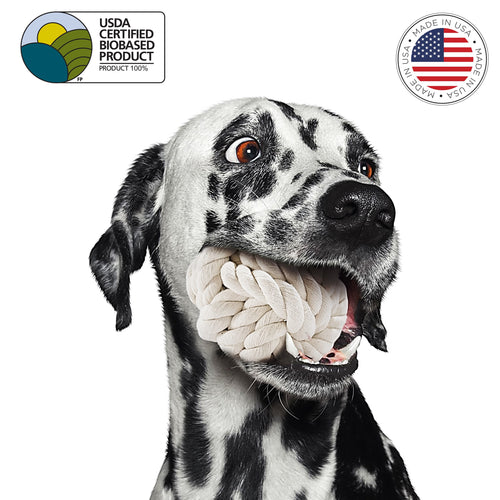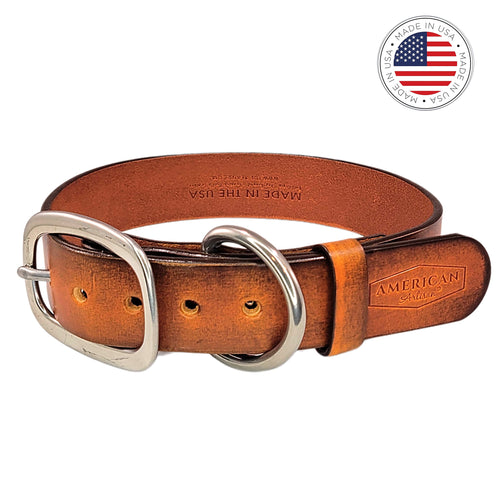Your Cart is Empty
Free 2-5 day delivery | No minimum purchase required
Free 2-5 day delivery | No minimum purchase required
Shop
Learn
10 Tips for Training Blind Dogs from Expert Trainers
 by K Marie Alto Updated
9 min read
by K Marie Alto Updated
9 min read

We love our fur babies no matter what size, shape, and personality they may have. One thing that we have to acknowledge, though, is that not all dogs have the same capabilities.
Obviously, there are differences between breeds; a tiny breed isn't going to be able to pull a dog sled, while a huge breed will have trouble running an agility course, and some are better trackers or hunters than others.
Beyond that, though, we have to think about physical disabilities. Just like people, dogs can be born with congenital defects that hinder their abilities. Others might contract illnesses or suffer injuries when they're very young.
Blindness is not a common problem in young dogs, though it can still occur. Those puppies deserve just as much love and affection as any other, but many people may be unwilling or unable to provide them with the care they need. Training a blind puppy can present a lot of challenges, but with dedication, time, and love, they can be overcome.
If you're willing and able to care for a blind puppy and train them in all the things they'll need to know when they grow, I salute you. To help, I've put together this list of ten of the most useful tips I can find, backed by expert dog trainers and behavioralists.
Let's get right to it!
Table of Contents
1: Understand Differences
One thing that can be worth thinking about is when your dog lost their sight.
Some dogs are born with either very limited or no vision. These dogs don't know anything different, and while those around them might act as though they can see, the blind puppy doesn't know that. Your puppy will adapt to not having sight with relative ease as long as you're there to help care for them.

For puppies who lose their sight early to injury or illness, don't lose heart. They will still be able to adapt, and probably quickly, too. They just won't adapt quite as fast, because they were learning how to navigate the world with sight, and they lost it and have to learn to compensate.
At the same time, these dogs have some advantages in having some basic idea of what the world is like and what scents might represent, even if they haven't really interacted with it much. They'll probably lose this over time, but it can help overcome some initial hurdles.
As for dogs that lose their vision later in life as mature adults or seniors, there is a whole other array of challenges to consider. Since you aren't as likely to need to train them, though, that's somewhat outside the scope of this post. Some of the tips can still help, though, so keep reading!
2: Be Gentle and Patient
The Browns from Alpha Paws Training recommend being patient and gentle when training a blind pup. Blind dogs may be slower, more hesitant, and less confident in their explorations of the world around them.
They will still be receptive to learning new things, but the usual dog training schedules might not apply. You'll probably need to take longer to train them in certain things and be kind and gentle if they're having issues or accidents.

This is one of the greatest challenges of training a special needs dog. It can feel like they're stuck in their training or they aren't making progress fast enough, and it can be disheartening. Many people have a crisis around this time and consider giving up their pups to someone who has more time and ability to train them.
In my view, as long as you aren't neglecting them or made a promise to do something you couldn't, there's no shame in giving up a special needs pup. They deserve love and care, and if you can't provide it, it's better to hand them over to someone who can instead of struggling in a way that hurts both you and the puppy in the long run.
3: Create a Household Scent Map
Jennifer Mauger, a contributor to Chewy, says one of the most important things you can do is build a household scent map.
A household scent map is a fairly simple thing to build; all you need to do is get something like a bottle of vanilla extract or a lavender essential oil. Rosemary, Cedarwood, and Frankincense are all also good options. These are all scents dogs like and are pleasant enough to people that they won't be unpleasant.

A scent map just means you take that scent and dab a little bit of it on various parts of your home where your dog should know something is there. Corners, doorways, the legs of furniture, even walls.
Since your dog will have a keen sense of smell even though they're blind, they can use this to build a mental map of where things are. This helps them avoid running into walls or furniture, so it's both safe and enjoyable for your pup.
You can even dab some scent on their toys so they know where to find them! You don't need to use different scents for everything (though you can use different scents for different categories of objects, like one for walls and one for toys); just one or two will serve the purpose.
4: Use Clicker Training
Susan Gary of Top Dog Pet Sitters highly recommends clicker training. A clicker is just a small, sharp noisemaker with a button that makes a click when you press it. It's an auditory signal that a blind dog can learn and hear; critically, it's unique enough that your dog won't mistake other noises for it, which is essential for reliable training.

The click alone doesn't mean anything. Your first task with clicker training is to associate the click with a positive outcome, usually a treat. Just click and offer a treat periodically throughout the day to associate the noise with the reward.
Once that's in place – and it won't take long – all you need to do is use the click to identify a specific behavior you want to reinforce. So, say you're teaching your blind puppy to sit; when you say sit, and they sit, the instant their butt touches the ground, click and reward. Eventually, you can drop the reward aspect; the click is enough to reinforce a behavior.
You can read more about clicker training in this guide from the American Kennel Club.
5: Teach a Stop Command
Another important element of training a blind dog is training them to stop on a dime. You can't afford a dog that will run wildly and ignore your commands; there are all kinds of things they can run into or encounter that can be dangerous.
Moreover, there's only so much you can do to dog-proof everything around you. In your house, sure, you can keep things out of head level or away from their common paths, as well as scent-mark things that can't be removed. But other things can change or can't be marked. The edge of a pool or a pond, the trailer hitch on a truck, road traffic, the list goes on.

In these cases, having a firm command that your dog always obeys and that gets them to stop no matter what is critical.
6: Teach Step Up
Another useful command to teach your blind pooch is "step up" or "step down." These are simple commands that serve to warn your pup that a step like a curb or other short stumbling block is just ahead. This can help prevent tripping up or down that step.

While a single misstep is unlikely to cause an injury, it can lead to them being more cautious and hesitant because they don't know when the ground is going to jump out at them (or drop out from under them.)
If you've ever been leaning back in a chair and felt that jolt of almost falling or missed a step when climbing the stairs, imagine how they feel with the same experience but no eyesight.
7: Consider Household Safety
Lara Shannon of Pooches at Play recommends taking some serious time to make your household as safe as possible for your dog. Get down on their level and look at anything that could be head level or below that could cause an issue.

Consider things like:
-
Adding corner protectors to doorways and other corners so that even if your dog gets excited and runs into one, they don't hurt themselves.
-
Baby gates at the top of staircases so that your dog can't trip and fall down them, potentially injuring themselves in the tumble.
-
Adding rugs or other surfaces to slippery floors and other footing hazards.
-
Removing fallen branches and other low hazards in your yard where they could run into them while playing or doing their business.
-
Adding markers around trees and other outside objects that can't be reliably scent-mapped; a simple ring of a different surface a foot or so out from the trunk of a tree can help warn your pooch something is coming up.
How much you do and what you need to focus on will depend on where you live and what your dog is like. Consider things from their perspective and make them as safe as possible.
8: Don't Rescue Them
Gillian Young, from the Wonder Dog Institute, says one thing you need to do is avoid "rescuing" your pup from common obstacles. It's one thing to snatch them up from a dangerous situation; that's fine. What you want to avoid is "rescuing" them from things that are just a little hard for them.
For example, if your blind dog is having trouble climbing stairs, your goal is to train them to be more confident going up and down the stairs. If you just pick them up and bring them up the stairs in your arms, it can hinder their training and even disorient them.

Blind dogs rely on their other senses to get around, and a big part of that is building and maintaining a mental map of your home and the things in it. Picking them up and putting them down somewhere else means they have to spend time figuring out where they are, and that isn't always easy. Scent maps help, but it's still better not to do it to them in the first place.
Guiding and helping them remain independent is better in every respect.
9: Don't Do Too Much At Once
This is less of a specific tip and more of a story you can take a moral from. Mardi Richmond of Whole Dog Journal tells the story of Orbit, a blind dog who was well-trained and socialized by his parents. One of the biggest challenges he faced was sound, particularly ambient noise.

Blind dogs use scent to map the area around them, but they also use sound to build that awareness. They can hear quite well, too, and can get a lot of information from ambient noise.
The challenge is that we people often tune out a lot of that noise or take it for granted. Things like crowds, traffic, loud machinery, and other noises can be disregarded because we know what they are.
The trouble is, for a blind dog, that's all potentially relevant information. Suddenly being immersed in it can disorient and overwhelm them, especially if they aren't used to it. So, when you're introducing them to new circumstances, be mindful of the noise.
10: Work on Socialization with Well-Trained Dogs
Another tip from the Orbit story is to be slow and careful when socializing your blind dog with other dogs. Since your pup is blind, they won't be able to see the visual cues that other dogs give and expect to be received. Whether it's play bows, social hops, attempts to sniff, or just a wagging tail, it just won't be seen.

So, if the other dogs your dog is learning from are rambunctious, aggressive, or unlikely to recognize a dog without the right social cues, it can cause a communication issue.
The ideal is to make sure you're socializing your pup with stolid, calm, and unflappable dogs that can be just as graceful to a social faux paw as you will be.
As always, if you have any questions, please feel free to let me know! I'd be more than happy to help however I can!
Safe, Sustainable, and Stylish Supplies for Your Dog
Your dog is family, and at toe beans, we treat them that way. That’s why we’re obsessed with creating products that keep your furry companion healthy, happy, and safe—without compromises or shortcuts.
Looking for treats that are as healthy as they are delicious? Check out our USDA Organic Dog Treats, crafted with 100% organic ingredients to nourish your pup without harmful additives. Grooming is easy and gentle with our Organic Dog Shampoo and Dog Brushes, both designed with the premise that, just like you, your dog has delicate skin too.
Playtime becomes worry-free with our USDA-Certified Biobased Dog Toys. For the most pleasant walks, our US-made Leather Dog Accessories combine durability with elegance, ensuring your dog looks and feels in style all the time.
Every product in our small but growing catalog reflects our passion for creating better, safer options for your beloved pup.
Discover the difference toe beans makes, shop dog supplies today!
K Marie Alto
K. Marie is an animal lover, wife, kitty mom, dog auntie, writer, and co-founder of Toe Beans, a proud American family-owned online boutique pet supplies store focused on the improvement of the life of furry family members via pet parent education, better products, and advocacy. She has over 20 years of experience as a pet momma. She loves sharing her personal journey and experience as a pet parent via her blog and Facebook page where she currently has more than 50K followers (@furrytoebeans) and counting :-). Read more
Leave a comment
Comments will be approved before showing up.
Also in Pet Parents Blog by Toe Beans

Techniques To Stop Your Cat from Begging While Eating
by K Marie Alto April 10, 2025 10 min read
Learn how to manage your cat's begging behavior during meal times with effective techniques that enhance comfort and ensure their safety, as well as yours.

The Truth Behind Zeus, The World’s Largest Great Dane
by K Marie Alto April 03, 2025 10 min read
Learn about Zeus, a gentle giant and therapy dog who holds the record as the world’s tallest Great Dane, showcasing his lovable nature and impressive stature.

Bengal Cat Guide: History, Health, and Personality Traits
by K Marie Alto March 27, 2025 9 min read 2 Comments
Learn about the Bengal cat with our guide, covering their history, health, and personality traits to help you decide if this striking breed is right for you.
Related Products

Dog Rope Toy | The Bio-Ball
$15.99

Dry Dog Shampoo | USDA Organic | Made in the USA
$19.95

Leather Dog Collar | Full Grain Spanish Leather | Made in the USA
$54.99
Recent Articles
- Techniques To Stop Your Cat from Begging While Eating April 10, 2025
- The Truth Behind Zeus, The World’s Largest Great Dane April 03, 2025
- Bengal Cat Guide: History, Health, and Personality Traits March 27, 2025
- How Can You Stop Your Dog from Licking Their Paws? March 20, 2025
- Why You Should Invest in Automatic Pet Water Fountains March 13, 2025
- Guide: The Ultimate List of Fruits That Your Dog Can't Eat March 06, 2025
- Is Your Cat in Heat? The Signs and What You Should Know February 27, 2025
- Dog Spay Surgery: What Symptoms Can You Expect After? February 19, 2025
- DIY Tips for Making Healthy Homemade Cat Food Recipes February 13, 2025
- 10 Tips for Training Blind Dogs from Expert Trainers February 06, 2025
